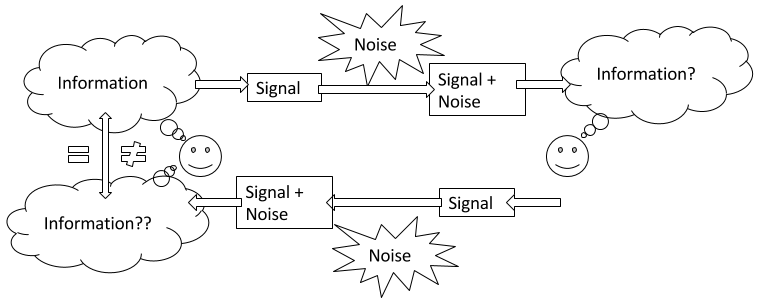Model of Communication for Information Sharing
In How To Do Things, I mentioned that in order to thrive in the world, one of useful things to do is to focus on communication. Here is a model of communication for information sharing.1

When I speak of focus on communication, I mean that both the information sender and the information receiver have a shared mental model for communication that resembles something like the above. I also expect them to understand that the purpose of communication in this context is to share information. Most importantly, I expect the sender and receiver to understand all the ways in which the communication process can result in failure to transmit the intended information.
In this model, there are three sources of error in communication. The first source of error can occur when information is encoded into a signal, for example, when we translate an idea in our minds into words, the many meanings of the words may or may not correspond to what we mean to communicate. The second source of error can occur when noise alters the signal, for example, having a conversation in a loud room can result in the recipient not hearing a word correctly, or perhaps not hearing a word at all. The third source of error can occur when information is decoded from signal back into information, for example, for words with multiple meanings, the recipient may choose to select a meaning that the sender did not intend.
What is important to notice is that even in the total absence of noise, we still have two sources of error, the sender encoding the information, and the receiver decoding it.
Before we get into how to correct encoding and decoding errors, let’s consider how can we detect errors in communication in the first place.
One effective way of detecting errors is to ask for a confirmation brief from the receiver. In other words, ask someone to repeat back to you what you just told them. Using this method, the recipient encodes the information received into a signal, the signal (plus noise) reaches the original sender, who then decodes the signal into information. The original sender then compares the original intended information with what they decoded from the confirmation brief and can decide whether or not the information is close enough to what they intended or whether further clarification is needed.

The confirmation brief method of error detection can be initiated by the sender of the information, or by the recipient. Also note that saying “I understand” is insufficient to be considered a confirmation brief as it allows for no comparison by the sender.
So, how do we correct encoding and decoding errors when two people are attempting to communicate with each other? For one, encoding and decoding are done by separate people. The error correction can happen (or can fail to happen) independently of the sender and the recipient. The mechanism of encoding and decoding typically involves assumptions about what the other person means to communicate and how they mean to communicate it. The sender, chooses words2 and other media to encode information into a signal and using confirmation brief observes how effectively the recipient understood the intended information. When further clarification is needed, the sender can provide more detail, but alternatively, the sender can choose to encode information using different words, or different media in order to help the recipient understand. A good sender is a person who can modify their encoding to make continual progress in reducing the gap between what they intended to communicate and what they receive in the confirmation brief. Similarly, on the receiving side, a good receiver is a person who can modify their decoding to make continual progress in reducing the gap between what they provide in the confirmation brief and what the sender intends to communicate. The sender confirms understanding once the sender decides that the confirmation brief is close enough to what they intended to communicate.
In brief, “focus on communication” requires participants to have a mental model for communication and awareness of all sources of error that can impede communication. Participants should continually strive to improve the repertoire of encodings and decodings available to them. Effective communicators should continually strive to improve the methods for constructing and adapting information encoding and decoding processes.
Endnotes
1 What I present here is a human-centric simplification of Claude E. Shannon’s ideas that gave rise to the field of Information Theory. For his seminal paper and a much more detailed treatment of communication see C. E. Shannon (1948). A Mathematical Theory of Communication. The Bell System Technical Journal, Vol. 27, pp. 379–423, 623–656, July, October, 1948.
2 Notice that emergence of a context-specific jargon is a mechanism for reducing encoding and decoding errors by defining a dictionary of words and their context-specific meanings ahead of communication. However, it only works if the interpretation of the jargon meanings actually matches between sender and receiver. Furthermore, in order to arrive at the common interpretation of jargon, sender and receiver still need to go through the communication process to establish the common interpretation in the first place.
One comment